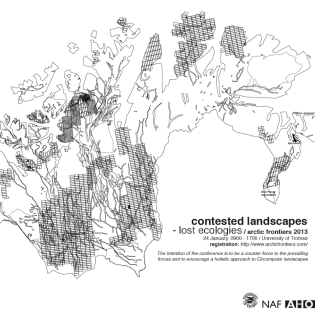Contested Landscapes – Lost Ecologies
Conference
;)
- Time
- 24 January, 2013, 09.00 – 17.00
- Location
- University of Tromsø
Janike Kampevold Larsen together with Gisle Løkken organised the conference as a side event to the Arctic Frontiers conference at the University of Tromsø. Speakers at the event include key international contacts of the Future North project.
Arctic and Subarctic landscapes are more than ever contested as they are faced with an increased interest for mineral extraction and energy production. Such activities displace both traditional ways of living and landscape practices inherent to them. Well-balanced ecological systems comprising social, political, economical landscapes are disrupted by political and economical processes that transform them into mono-functional and mono-economical, industrial landscapes.
This conference aims to identify different transformation forces in the landscape. Are emerging technologies and industries in the circumpolar acceptable, and is their conception of landscape compatible to agents and practices that harbor a holistic view on these landscapes? We want to discuss the value systems at work in relation to such contested landscapes, and maintain the conceptions of them as something other than commodities, to encourage understanding of and relation to such landscapes on their own terms.
Just within the latest few years the notion of landscape in public debate has turned from a complex focus on primary lifestyles and industries to a simplified picturing of the landscape as a technical challenge for extraction industries. We want to address these issues and create a liminal space for counter hegemonical thinking and debate. The intention of the conference is to be a counter-force to the prevailing forces and to encourage a more holistic approach to circumpolar landscapes – one that brings considerations of social justice and small-scale economies to the table.
Speakers
Janike Kampevold Larsen (Norway) – Associate Professor at the Institute of Urbanism and Landscape, and project leader of the research project Future North, funded by Research Council Norway. She also coordinates the new Master in Landscape Architecture that will start at the University of Tromsø fall 2013. Last co-edited books: Routes, Roads and Landscapes (2010), Views, Norway seen from the road 1733-2020. She has published on contemporary infrastructural landscapes, and on the evaluation of contemporary landscapes.
William L. Fox (USA) – Director of the Center for Art + Environment at the Nevada Museum of Art in Reno. Fox is a poet and writer whose work is a sustained inquiry into the ability of human cognition to transform land into landscape. His numerous nonfiction books rely upon fieldwork and interaction with artists and scientists in extreme environments, a setting that provides narratives through which he conducts his investigations. His books include Driving to Mars (2006),Terra Antarctica: Looking into the Emptiest Continent (2005), and The Void, the Grid & the Sign, traversing the great basin (2000).
Kjartan Fløgstad (Norway) – Writer. Fløgstad is one of the most distinguished Norwegian fiction writers, associated both with magic realism and a burlesque essayistic style applied to realistic plots. Among several awards he received the Nordic Council’s Literature Prize for his 1977 novel reflecting on the industrialization of the Norwegian west coast, Dalen Portland (Dollar Road). He demonstrates profound knowledge of Norwegian industrial history with its subsequent transformation of the landscape, Russian mining policy in Norilsk, Kola, Svalbard, and Chile as well as of the political and wartime history of the north in books like: Pyramiden (2007), Grense Jakobs elv (2009), Nordaustpassasjen (the Northeast Passage) (2012).
Mattias Åhren (Sweden/Norway) – Researcher/Post Doc., Faculty of Law at the University of Tromsø. He has been deeply engaged in the indigenous rights discourse most notably the rights to culture, self-determination, non-discrimination and property, which also was a major focus in his doctoral thesis. He is head of the Saami Council’s Human Rights Unit. In this capacity, he has represented the Saami people in numerous United Nations processes, including in the successful negotiations on the UN Declaration on the Rights of Indigenous Peoples. Most recently he act as a legal advisor for Saami villages and reindeer herding districts in issues concerning conflicting interest between traditional Saami reindeer herding and extensive mineral extraction.
Julia Martin (England/Germany) – Doctoral candidate at Goldsmiths College, London, Department of Art. Her practice-based thesis investigates new philosophical concepts of ecology, and their theoretical and practical challenges for ecocritical art in times of climate change. Her artistic practice is strongly influenced by fieldwork, performative actions, landscape analysis and contextual research. Recent and ongoing projects have been based on repeated site visits to West Greenland, Scotland and Iceland.
Michael Bravo (U.K.) – Head of the Circumpolar History and Public Policy Research Group at the Scott Polar Research Institute, University of Cambridge (among several positions). He has written extensively on the role of scientific research in the exploration and development of the Arctic, exploring issues in historical epistemology including the philosophy of experiment, measurement in fieldwork, the nature of precision and calibration, science and technology in translation, and the historical emergence of new ontologies. His publications include Narrating the
Arctic (2002) and Arctic Geopolitics and Autonomy (2011).
Kari Anne Bråthen (Norway) – Plant ecologist employed as an Associate Professor at the University of Tromsø. She has 20 years of experience from tundra ecosystems in alpine and arctic ecosystems such as the Canadian Arctic, Spitsbergen, the Alps and Northern Norway. She has been engaged by the Department of Food and Agriculture and the Directorate for Nature Management for issues concerning ecosystems of tundra landscapes in Norway.



